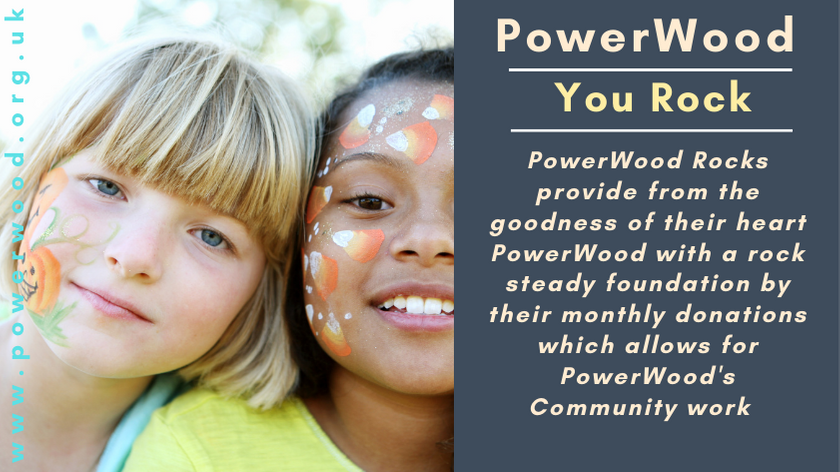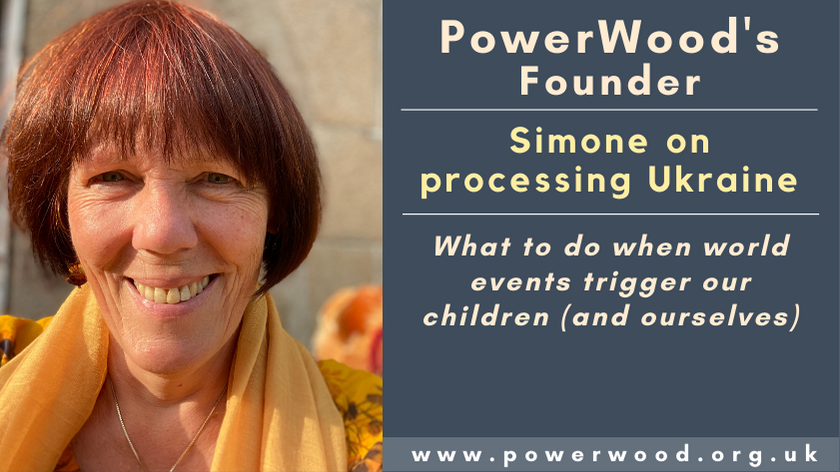
Many of our children will experience anxiety and fear around the situation in Ukraine, which is often exacerbated by the news and embellished by their rich imagination.
This post includes ‘Planting seeds of calm’ a MERT tool to calm a child about a big world event and introducing Active Listening and Narrowing Behaviours within the MERT Theory.
First off how does it affect us
We start by playing the detective, how is this situation affecting us and our child.
“I couldn’t believe it, I felt so overwhelmed and we were all so unsettled. Me nor the children slept well at all the first weeks” Mum of two
First we ask ourselves, is our baseline, our energy level and emotional resilience, affected by the situation in Ukraine, is there any change in our behaviour or emotional resilience?
For example we can ask ourselves:
- Are we overly checking the news?
- Are we developing bleak scenarios in our mind fueled by the situation, e.g. fears of a nuclear war?
- Are the children demanding more energy, while we have less?
- Are we overly worried that our children will be affected by the situation, is the conflict triggering bleak scenarios around the children’s future?
If we recognise that we are affected by the situation in Ukraine, our first port of call is to focus on our own baseline to enable us to hold the space for our children with emotional independence.
How does it affect our child?
Many children have difficulty expressing in words whatever emotional reactions have triggered them into the cycle of emotional and sensory overload, fortunately we often can notice their emotional reactions in their changed behaviour.
Possible signals might be:
- An evening routine, which has never been easy, is further stretched and it takes our child even longer to fall asleep
- A normally chatty child might be more withdrawn,
- Our child might be changing their eating behaviour
- Picking fights in a different more intense way, or lashing out physically suddenly
- Advanced arguers (read teens) might be lashing out verbally, showing contempt for the current world, feeling betrayed by the adults
- Our child overreacts to normal situations
- Our children might regress to behaviour from an earlier age to feel more safe, e.g. sucking a thumb again, wanting to talk for ages with mum in bed, becoming more clingy, reluctant to do new things, wanting to stay home, seeming to not be able to emotionally regulate themselves any more
- Increased or new narrowing behaviours that are traditionally associated with mental health issues.
Narrowing behaviours
Narrowing behaviours is an important concept within the MERT theory.
We believe neurodiversity is the result of normal, natural variation in humans. We celebrate this different way of looking at conditions or innate abilities, which have been traditionally pathologised. This point of view is increasingly supported by science, and is challenging widespread social norms and stigmas. Researchers doubt that certain mental disorders are disorders at all and allocate specifically depression, ADHD and PTSD to adaptive responses to adversity, thus stress-responses.
Narrowing behaviours are traditionally associated with mental health issues and in our eyes often are part of neurodiversity.
Flag ups
All people, children and adults alike, who are emotionally overloaded will flag up in some way. This can be by having a tummy ache, or a headache, being grumpy, lashing out, sleep issues, nail biting, or by trying to control the outside or the inner world by e.g. depression; anxiety; obsessive, repetitive or compulsive thoughts; phobia-related fears or any other ‘narrowing’ behaviour.
Children and adults who are displaying this type of behaviour are sharing that they are stressed, emotionally overloaded or uncomfortable, someone or something is draining their baseline or is amiss, and they are trying subconsciously to recreate a false sense of safety by having a sense of control at some level. They are stuck for now in the Cycle of Emotional and Sensory overload and need support to get out.
Check the changed behaviour
We can check if their changed behaviour is related to the situation in Ukraine by naming the changed behaviour and ask what’s the matter in an open fashion e.g.:
“You are not enjoying food the way you normally do, what’s bugging you?”
OR
“You seem to pick fights more often, is there anything bothering you?”
OR
“You seem so low, is there anything you are worried about?”
Before asking this question, ask yourself whether it is likely to trigger the child. If yes, we don’t ask and trust our instinct and apply the tools to support ourselves and our child. If not, we are careful in listening to what our child says and taking on board whatever they share with us.
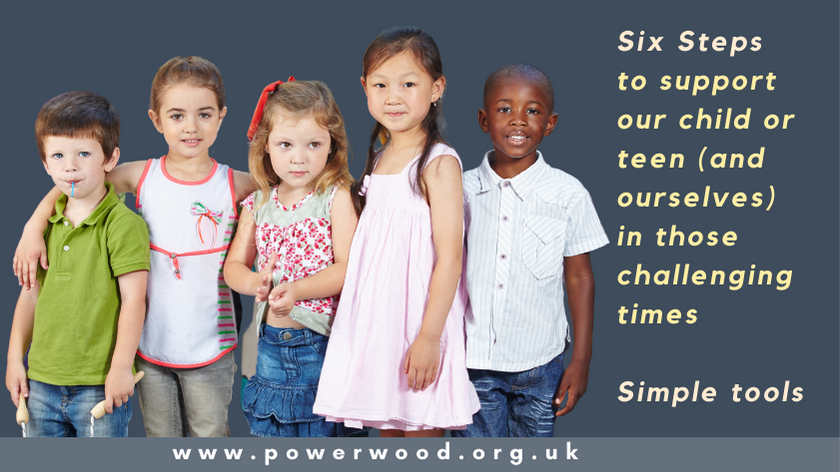
Six steps to support our child or teen (and ourselves)
1. Raising our child’s and our own baseline
Stress can have a huge effect on our child’s and our own baseline, our energy level and emotional resilience.
Besides maybe curbing the exposure to news around Ukraine that might trigger upset, we might also want to set the 4-7-8 breathing tool alarm regularly to calm our nervous system. This sends the activity of the synapses from the amygdala – the emotional overwhelm – to the fine-processing centre in our brain. In doing this, it helps us to be as emotionally resilient as we can be during those challenging times, and by extension enables us to hold the space for our children.
We might want to integrate our 4-7-8- alarm with the cuddle alarm (MERT tool) for our child, to strengthen our child’s baseline at the same time.
Our younger children we can support to process whatever is going on for them in a more practical way, giving them lots of cuddles, going for walks, playing outside, growing a garden, cuddling with a pet and through being creative, such as drawing or cutting and sticking. (For some great creative ideas visit PowerWood’s Creative Corner by Abigail.)
Physical connection, creativity, being in nature, and physically active can all help decrease feelings of fear and stress in children, teens and (young) adults alike.
Whenever our child is expressing feelings or thoughts around the war that are upsetting, or they express bleak scenarios, we apply the “Oh Sweety, …”(MERT tool) to help them calm when feeling overwhelmed.
2. Planting seeds of calm (MERT tool)
Our children will hear about the situation in Ukraine whether we try to keep it from them or not. Many of our kids have the intellectual ability to understand what is going on and the ability to imagine how it might affect the world in a bigger sense without the emotional maturity to cope with the emotional reactions in themselves. This is part of asynchronous development, in which the development of intellectual, emotional, practical and physical development are not synchronised.
The ultimate aim of planting seeds of calm is that children can develop an emotional grip on this overwhelming situation, and see a safe empowering way forward while learning how and where to focus the activity in their brain.
To help calm our children’s overwhelm we want to drip feed reassuring sentences, seeds of calm are reassuring, non emotive, factual and empowering. Sentences with content that help our children to move from feeling frightened and powerless towards feeling calmly empowered by doing something to help.
“I’m so glad so many people are working hard to resolve the conflict between Russia and Ukraine.”
Our task is to plant those seeds of calm without any emotion attached to prevent our children getting triggered into the cycle of emotional and sensory overload, and if they are there already that they are able to not use our reaction to stay in there any longer.
We just plant those seeds of calm, as a statement of fact, we don’t wait for any reaction, and we continue to go about whatever we are doing.
If our child says ‘Its so sad for the people in Ukraine’, confirm that without being emotional about it, and offer reassurance, say for example:
“Yes it’s sad, and I’m glad that so many people are working on ending the war and helping those people. Did you know that in the UK more than 150,000 people have offered a place for the families to be living safely until the situation is safe again, and that other countries are doing the same. Also many people are collecting money, clothes and whatever they need to help them and make them feel more welcome when they come here. Isn’t that great.”
We all feel better when we can help, and that’s also true for our children. So we can say to our child:
“Let’s research how best to help those people and find a small thing we can do to help.“
3. Critical thinking can calm
Another way to generate calm is to trigger the fine-processing centre of our brain by helping our child to apply critical thinking, or logical reasoning. This requires an (older) child or teen to think about the situation from another perspective, away from their emotional reactions.
When we are overwhelmed, the synapses in our brain are firing off in our amygdala, the primal part of the brain that tends to overrule the rest, so we lose access to the rational thinking brain, or the ability to move away from the situation to calm down.
To help to calm our child, we can help by activating parts of our brain that are more rational.
To calm our (younger) children we first might want to put the current situation in the bigger picture and stimulate them to use their rational thinking brain. We can point how far away Ukraine is, in miles and in time compared to somewhere that our child experiences as far away, for example to see their gran.
We can also take a map and let them count how many countries are between ours and Ukraine, and let them count how many seas and rivers have to be passed to reassure it’s far away answer and we are all safe.
“Ukraine is more than 1,600 miles away, that’s 100 times as far as driving to grandma and granddad, it’s … hours constantly driving.”
If our child is old enough to calculate more precisely we can trigger the calming critical thinking brain for example by asking how far Ukraine would be in miles compared to driving to see their gran.
We could search together for a (adapted to their age) historical and political explanation (which we prepare in advance) by simplifying the situation and giving an historic explanation that shows a ‘causal’ connection so it feels to our child like there is some logic to it.
The news in Ukraine – and other places – can be quite upsetting. Please let us remember that the news is only ever about bad things that are happening. They never tell us about the small, good things that happen every day – you will never read in the paper that someone helped an old lady across the road, or fed a stray cat, or phoned the farmer to tell some of his sheep were seen on the road. People can be really unkind, fortunately they can be very kind too – and it’s good to keep that in mind.
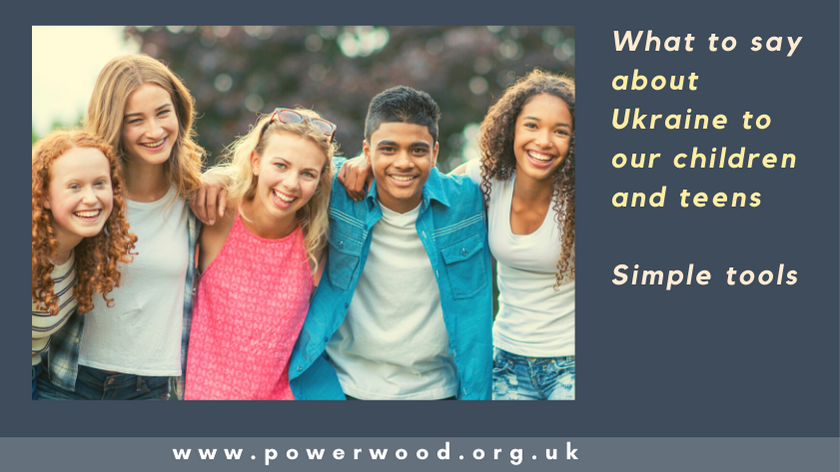
To help our older children to calm down we can trigger their intellectual ability with critical thinking questions like:
- What do you think is worse, the Covid pandemic or the situation in Ukraine? What makes you think that?
- Do you think the Covid pandemic has influenced the situation in Ukraine? What makes you think that?
- There are other conflicts in the world, in Yemen and Syria for instance. Do you think they are receiving the same attention?
These kinds of questions offer an opportunity to model active listening, which in turn help our children to absorb these skills themselves.
4. Modelling active listening
Active listening is the process of listening, focused on understanding and reflecting both the emotional experience and the ideological perspective of our child.
And again as a preparation we check if we have the time and the energy to really get into a topic as described above with our child or teen. Are we rested, fed? Do we have the emotional resilience to give our attention and be present?
During active listening we respond both verbally and non-verbally.
Verbal active listening
Verbally by asking open-ended questions, seeking further understanding of how situations affect our child and what their point of view is in a non-judgemental way, asking for specificity such as “what do you mean with … ”. And when our child shares something like “I wish that nobody was violent” we can ask: “What makes you say that?” or “ What makes that important to you?” We can demonstrate a grasp of what our child has said, by reflecting back what we have understood in a questioning way “ “If I understand you correctly, you mean …” projecting empathy with the child’s or teen’s point of view.
Non-verbal active listening
Non-verbally we can add positively to the conversation by looking attentive, nodding our head and most importantly smiling, as with pre-teens and teens, the lack of a smile will make them think that we are angry or worried because they are not able to correctly read emotions in the adult face.
5. Empowering our children by supporting Ukraine families
Just like us children and teens might experience, besides their fear, feelings of injustice and powerlessness and it might help them to be encouraged to get involved, to experience that they can do something to make the situation even a tiny bit better.
More information about what to think of when helping
- Ukraine: what you can do to help – GOV.UK about how to keep yourself self safe while supporting Ukraine and some more tips
- Safe giving to support Ukraine – GOV.UK about how to donate safely to Ukraine
- Ukraine help: What can people in the UK do? – BBC News an overview of reliable charities to donate to and where to bring clothing, bedding and sanitary items
For children and (pre) teens there are many ways to get actively involved in helping Ukraine’s families and children through collecting money.
“The best way to help is to make a cash donation.”
Sean Ryan, media director of Save the Children said collecting supplies like blankets or infant formula means transporting heavy goods hundreds of miles, whereas cash can reach people quickly to buy what is needed
For example children and (pre) teens can sell their outdated or unused toys online or they might organise a cake sale to collect cash to donate for Ukraine.
6. As always, have a contingency plan ready
Contingency plans are a helpful tool for if we are not feeling calm when our child asks us a question, or expresses their overwhelm.
We can start by giving ourselves a minute to regroup, perhaps by going to the toilet and applying the awareness mantra:
‘Im proud and grateful to be aware I have an unhelpful thought / feeling / action*”
*Whatever is applicable
To be followed up by the 4-7-8 breathing tool to calm our nervous system. If after doing this we feel able to answer, we can apply some of the tools and strategies above.
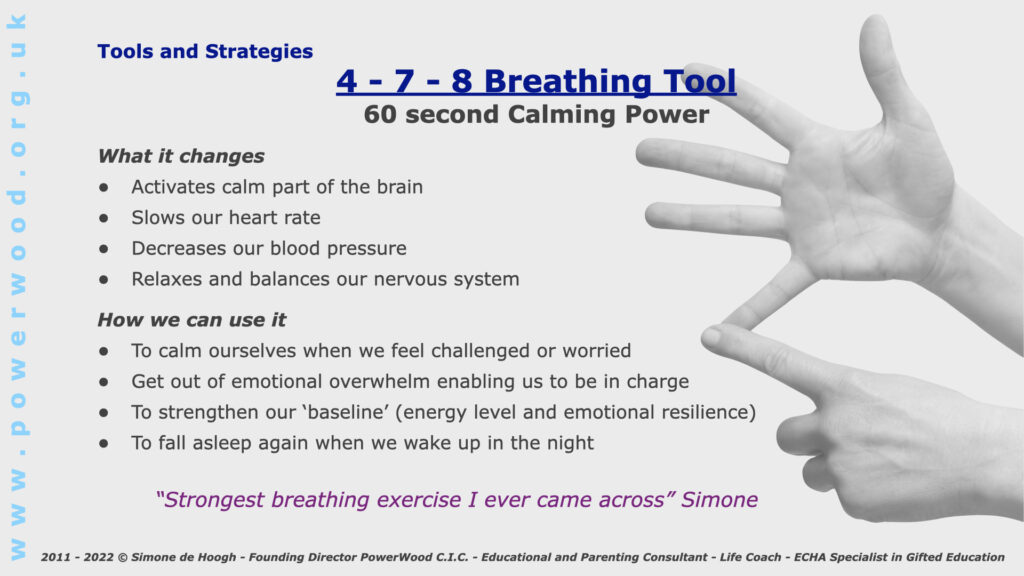
If we have neither the energy nor the emotional resilience to hold the space for our cuddly child, we might just sigh and say: “it’s indeed so sad, let’s have a cuddle to make us feel better and watch some cute animal videos”, or we might have prepared a calming film afternoon where we watch a familiar reassuring film while cuddling together, creating oxytocin, the bonding hormone that also helps to calm.
If our child doesn’t particularly like to be touched we might propose to get creative together, or sing a song, or dance together or go for a walk in the nearby park or in nature, to calm our nerves and feel connected through sharing, moving and nature.
Wishing you all during those challenging times lots of energy, strength and love.
© 2022 Simone de Hoogh, senior coach and educational and parenting consultant, and founder of PowerWood. All posts by Simone de Hoogh
Help us to continue support to all neurodiverse families and individuals
PowerWood offers to neurodiverse families understanding, simple tools and strategies that enable us to support ourselves and our children through emotional overwhelm. If you enjoy reading the articles please support PowerWood making all information available to all by becoming a PowerWood Community FreeBee or Friend member. Thank YOU!

